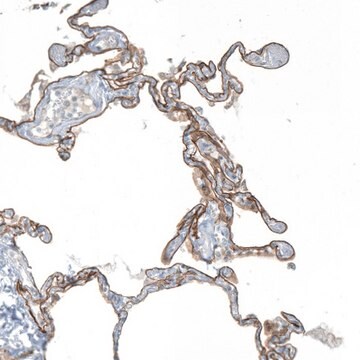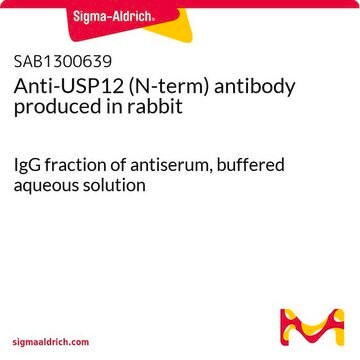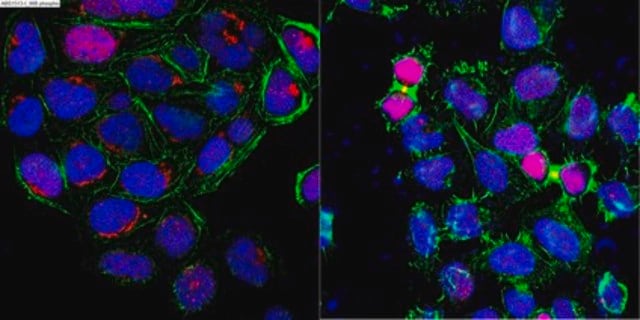一般說明
We are committed to bringing you greener alternative products, which adhere to one or more of the 12 Principles of Green Chemistry. This antibody is preservative-free, produced without the harm or sacrifice of animals and exceptionally stable to allow for ambient shipping and storage if needed, and thus aligns with "Waste Prevention", "Designing Safer Chemicals" and "Design for Energy Efficiency".
Click here for more information.
ZooMAb® antibodies represent an entirely new generation of recombinant monoclonal antibodies. Each ZooMAb® antibody is manufactured using our proprietary recombinant expression system, purified to homogeneity, and precisely dispensed to produce robust and highly reproducible lot-to-lot consistency. Only top-performing clones are released for use by researchers. Each antibody is validated for high specificity and affinity across multiple applications, including its most commonly used application. ZooMAb® antibodies are reliably available and ready to ship when you need them.
特異性
Clone 1E9 is a ZooMAb® rabbit recombinant monoclonal antibody that specifically detects Platelet-activating factor acetylhydrolase (PAFAH). it targets an epitope within 23 amino acids from the N-terminal half.
免疫原
KLH-conjugated linear peptide corresponding to 23 amino acids from the N-terminal half of human Platelet-activating factor acetylhydrolase (PAFAH).
應用
Quality Control Testing
Evaluated by Western Blotting in RAW264.7 cell lysate.
Western Blotting Analysis: A 1:10,000 dilution of this antibody detected PAFAH/PLA2G7 in RAW264.7 cell lysate.
Tested Applications
Western Blotting Analysis: A 1:1,000 dilution from a representative lot detected PAFAH/PLA2G7 in lysates from HL-60 cells, Human spleen tissue and Rat spleen tissue.
Immunohistochemistry (Paraffin) Analysis: A 1:1,000 dilution from a representative lot detected PAFAH/PLA2G7 in Human spleen tissue sections.
Immunofluorescence Analysis: A 1:1,000 dilution from a representative lot detected PAFAH/PLA2G7 in Human spleen tissue sections.
Affinity Binding Assay: A representative lot of this antibody bound PAFAH/PLA2G7 peptide with a KD of 1.1 x 10-7 in an affinity binding assay.
Note: Actual optimal working dilutions must be determined by end user as specimens, and experimental conditions may vary with the end user.
標靶描述
Platelet-activating factor acetylhydrolase (UniProt: Q13093; also known as EC:3.1.1.47, PAF acetylhydrolase, 1-alkyl-2-acetylglycerophosphocholine esterase, 2-acetyl-1-alkylglycerophosphocholine esterase, Group-VIIA phospholipase A2, gVIIA-PLA2, LDL-associated phospholipase A2, LDL-PLA(2), PAF 2-acylhydrolase) is encoded by the PLA2G7 (also known as PAFAH) gene (Gene ID: 7941) in human. PAFAH/PLA2G7 is a lipoprotein-associated calcium-independent A2 involved in phospholipid catabolism during inflammatory and oxidative stress response. It is a secreted protein that is synthesized with a signal peptide (aa 1-21), which is subsequently cleaved off to produce the mature protein. In plasma, it is reported to associates with both LDL and HDL particles. At the lipid-aqueous interface it is shown to hydrolyze the ester bond of fatty acyl group attached at sn-2 position of phospholipids. It specifically targets phospholipids with a short-chain fatty acyl group at sn-2 position, however, it can hydrolyze phospholipids with long fatty acyl chains, only if they carry oxidized functional groups. PAFAH/PLA2G7 also hydrolyzes and inactivates platelet-activating factor (PAF), a potent pro-inflammatory signaling lipid that acts through PTAFR on various innate immune cells. It also hydrolyzes oxidatively truncated phospholipids carrying an aldehyde group at the omega position, preventing their accumulation in low-density lipoprotein (LDL) particles and uncontrolled pro-inflammatory effects. Mutations in PLA2G7 gene have been linked to Platelet-activating factor acetylhydrolase deficiency (PAFAD) that leads to impaired response to inflammatory agents and leads to inflammatory gastrointestinal disorders, asthma, and atopy. This ZooMAb® recombinant monoclonal antibody, generated by our propriety technology, offers significantly enhanced specificity, affinity, reproducibility, and stability over conventional monoclonals. (Ref.: Stafforini, DM., et al. (1999). J. Biol. Chem. 274(11); 7018-7024; Tjoelker, LW., et al. (1995). Nature. 374(6522); 549-553).
外觀
Purified recombinant rabbit monoclonal antibody IgG, lyophilized in PBS with 5% Trehalose, normal appearance a coarse or translucent resin. The PBS/trehalose components in the ZooMAb formulation can have the appearance of a semi-solid (bead like gel) after lyophilization. This is a normal phenomenon. Please follow the recommended reconstitution procedure in the data sheet to dissolve the semi-solid, bead-like, gel-appearing material. The resulting antibody solution is completely stable and functional as proven by full functional testing. Contains no biocide or preservatives, such as azide, or any animal by-products. Larger pack sizes provided as multiples of 25 µL.
重構
300 µg/mL after reconstitution at 25 µL per vial. Please refer to guidance on suggested starting dilutions and/or titers per application and sample type.
儲存和穩定性
Recommend storage of lyophilized product at 2-8°C; Before reconstitution, micro-centrifuge vials briefly to spin down material to bottom of the vial; Reconstitute each vial by adding 25 µL of filtered lab grade water or PBS; Reconstituted antibodies can be stored at 2-8°C, or -20°C for long term storage. Avoid repeated freeze-thaws.
法律資訊
ZooMAb is a registered trademark of Merck KGaA, Darmstadt, Germany
免責聲明
Unless otherwise stated in our catalog or other company documentation accompanying the product(s), our products are intended for research use only and are not to be used for any other purpose, which includes but is not limited to, unauthorized commercial uses, in vitro diagnostic uses, ex vivo or in vivo therapeutic uses or any type of consumption or application to humans or animals.










